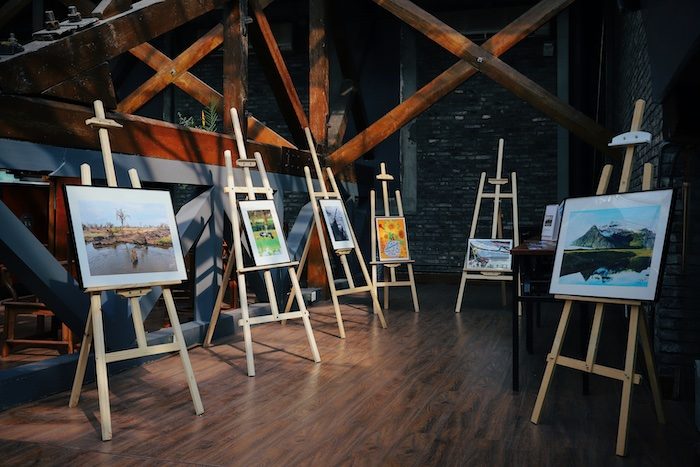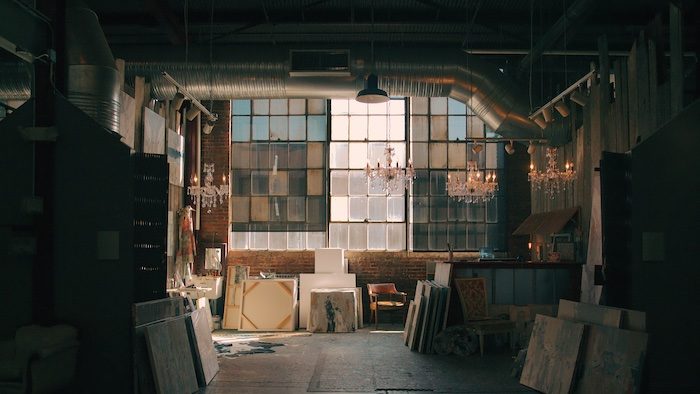You’ve worked hard, experienced some major successes, but now the artwork is piling up and the walls are caving in. If your at-home artist studio simply isn’t cutting it anymore, it may be time to look elsewhere. But how, exactly, do you find the right space, and what should you be looking for?
There are, of course, many things that you’ll need to consider when choosing an artist studio or workspace, but we’re here to break down the process and give you the confidence you need to make smart decisions and proceed with some pep in your step. From the amenities that you should be looking for in the physical space to what you can expect from studio neighbors and your future landlord or property manager, let’s simplify the process so you can proudly enter the next phase of your career.
We promise: this is an exciting development! So let’s get you prepared.
Establish priorities for your artist studio
While workloads can vary from week to week, most professional creatives will spend at least 40 hours in their workspace. So finding the right artist studio should be treated like you’re looking for a second home. However, depending on your local real estate market and budget, you may not have the luxury of being super picky.
One solution? Allow for some flexibility and be open to the idea of a shared space. One person we spoke with mentioned, “I would say be open to sharing first of all. We cram as many artists into our studio spaces as we can realistically fit.” You’ll ultimately have a greater selection if you’re willing to share, and you’ll ideally be able to experience other benefits, as well: from being able to bounce ideas off of other creatives to experiencing a sense of camaraderie (a much needed asset in what can sometimes be an isolating profession), sharing an artist studio can do more than just save money. Ultimately, it can establish the foundation for a bustling creative community.
This compromise, however, does open another can of worms: if you’re planning to share a space, being thoughtful about who you’re sharing it with can have a huge impact. Aside from the possibility of interpersonal conflicts, you need to be sure that you’re creating an environment that also allows the creative juices to flow. We’ve gone into the pros and cons before, but a good rule of thumb is to treat the process just as you would if you were looking for a roommate: you want to find someone that you can get along with well, but that isn’t your best friend.
In addition to thinking about a shared space, what else should you consider? Think about your medium and what might be a real deal-breaker. If you’re a painter that works in oils, windows and ventilation are absolutely critical—both for the quality of your work and, more importantly, your health. Airflow in general can also be incredibly important, and access to outlets and power sources are also key.
Another important consideration? You’ll need to think about accessibility. If you’ve set your own schedule, you know precisely when you’re able to create your best work, so be sure that you have access to your artist studio during that time. Most studio spaces provide tenants with 24-hour access, however many creative co-working artist studios have different rules. It may sound cliche, but many creatives have a tendency to work at odd hours. So having around the clock access can be incredibly important.
You may also want to have a conversation with potential studio mates and landlords about the possibility of modification. Depending on the tools you use or even other variables like needing to protect expensive equipment, modification can be just as important as safety and security.

It’s important to protect your work – and your business.
Location, location, location
It’s absolutely essential that you give a lot of thought to where your artist studio is located. If it’s a long commute, inaccessible by public transportation, or surrounded exclusively by expensive parking solutions, it will be incredibly difficult—both psychologically and physically— to access your space regularly.
Make sure that the spaces you’re considering are located in safe and accessible areas, and think honestly about whether or not it’s easy to access. If you know that there’s an exciting creative hub but it’s clear on the other side of town, you might want to reconsider.
Speak with other artists and ask if they have any recommendations. Or, you might post to neighborhood Facebook groups to see if there’s something both usable and affordable in your area. While a pre established artist studio might be ideal, there are a number of creative solutions that you can employ: the important thing is that it works for you. Besides, an unconventional solution can always be ripe with unexpected inspiration and other perks.
Consider the commute
In addition to location, you’ll also want to think about how your commute will be affected year round. If your artist studio is located a 30 minute walk away but you experience brutal winters, you’ll want to give serious consideration to how you’ll access the space year round. Is parking readily available? Is there bike storage? Is there reliable public transit that won’t leave you stuck in the cold?
Depending on where you live, it can also be smart to think about traffic conditions. If you live in Los Angeles, for example, just a few miles can feel like you’re traveling to the other side of the world. Identifying options like reliable trains or even your ability to avoid rush hour traffic can make your commute so much more palatable.
Keep safety in mind
In addition to your precious artworks, you need to keep valuable materials and your person safe and sound. Building and studio safety is therefore critical when considering where to rent your artist studio.
Be sure to ask about fire escapes, sprinkler systems, and city permits, and try to scope out the neighborhood before committing to signing a lease. While it can sometimes be a challenge to find a space that is properly permitted and up to date with their fire safety inspections (especially in more industrial areas), sticking to this requirement can quite literally save your life.
Check out CERF+, or the Craft Emergency Relief Fund, and follow their artist studio safety section and guide to help you think like a building inspector and ensure that all of your bases are covered.
Consider noise, heating, and ventilation when choosing an artist studio
Once you’ve started to narrow your choices down, you want to dig into the details of each individual space. That means speaking with current tenants about things like noise levels, ventilation, electric hookups, and temperature. It’s also smart to think about how you might affect the current community: while any working artist should think about how noise affects their work, it’s important to think about how the noise you make might impact others. If you’re a sculpture banging away at metal, a relatively noisy space could actually be a good fit as it signals that your neighbors are willing to tolerate the noise.
If you’re working with odorous or potentially toxic materials, be sure to ask about ventilation. And don’t hesitate to get hands on: do the windows open, for example? Many older buildings have poor insulation and no air conditioning, so you’ll need to think about whether fans and space heaters might be necessary, if they’ll be enough to keep you comfortable, and whether or not they’ll be safe to use in the space. Another pro tip: be sure you’re crystal clear on who pays the electricity bill and how it’s tabulated, as these costs can quickly add up.
Finally, take a look at which direction the windows face: you don’t want to underestimate the power of the sun. Direct sunlight, while beautiful, can quickly become cumbersome in certain situations, and you don’t want to commit to an artist studio that feels uninhabitable half the day.

It can take a little searching, but your dream artist studio is out there!
Understand your lease and get to know your property manager
While legal responsibilities and tenant rights vary by country and state, the general rule of thumb is to sign a one-year lease (at least), that’s reviewed by a lawyer, for your artist studio to protect both your artwork and your business. In addition to affording you a sense of security, this type of stability also allows you to put the focus back on what matters most: your work. If you’re anxious about having to constantly pack up shop and relocate, it can ultimately detract from your creative process and even put things on hold. Sometimes, proper evolution is best facilitated when you also know that your future is secure.
Be near other artists
When you’re a visual artist, it’s not uncommon to work in isolation in your artist studio. And while a certain level of solitude can be important when focusing, it’s also important to be near other artists.
Being a part of a larger community means benefitting from a built-in support system, feeling more motivated to create, and having access to a creative network. Most artists want to be involved in places that feel like they’re bustling, with common spaces where they can showcase their work, and many artist studios require a certain level of involvement from its members.
Even when you’re a solitary artist, it can benefit your practice and mental health to be in close proximity to creatives that share similar motivations and goals. So why go it alone?
Understanding what you need in an artist studio, what your priorities are, and being realistic and willing to compromise will ultimately make your search for a great space less of a hassle and easier to navigate. And while it can seem overwhelming at first, we promise you that thoughtfully taking your time will turn that first lease signing into a moment of celebration.
So what are you waiting for? From a network of supportive creatives to an inspiring space that helps you find a healthy work-life balance, your next chapter might be just around the corner.
Have you had success in finding an artist studio? Or some horror stories that you’d like to share? Let us know in the comments – we want to learn from you, too!
